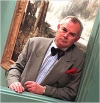Patrick McCaughey

Patrick McCaughey is former Director of the National Gallery of Victoria, the Wadsworth Atheneum in Hartford Connecticut, and the Yale Center for British Art. His most recent book is Strange Country: Why Australian Painting Matters (2014). His other works include Voyage and Landfall: The Art of Jan Senbergs (2006). He writes regularly for the Times Literary Supplement and Australian Book Review. He lives and works on the banks of the Quinnipiac River in New Haven, and has recently finished editing Fred Williams: Diaries 1963–1970 for the Miegunyah Press.
Peter Timms is ‘dismayed’ by the state of contemporary art and by the hype that surrounds it and the reality of the experience. He has written a book mired in exasperation and frustration. It is not hard to share Timms’s sentiments. Visit any sizeable biennale-type exhibition and you are engulfed in flickering videos in shrouded rooms, installations of more or less hermetic appeal, large-sca ... (read more)
The discipline of art history in Australia has passed through four stages. The foundations were laid in the 1940s with the arrival of three eminent émigrés. Ursula Hoff, schooled in the rigours and erudition of the Warburg Institute, came first. Franz Philipp, a Dunera survivor, well educated in the Viennese School, under Julius von Schlosser and others, came next. Then came Joseph Burke, first ... (read more)
Over the past three decades, Edmund Capon has transformed the Art Gallery of New South Wales. Before he arrived, you could have swapped the contents of the Sydney gallery with Ballarat’s and nobody would have noticed the difference. How a city of that size, wealth and international ambition could have wound up with such a provincial collection puzzled the mind. No more. Capon has thrown out new ... (read more)
This book must win the prize for the most lavish and the most amateurish book on an Australian artist. Not one of the 200 odd colour plates is dated; not even in the portentously titled Opus Index (a list of plates without page numbers!) do we get a single date or indication of present ownership. Where dates are given in the text, they are often vague and careless ‘... in the 1950s...’etc.
Ea ... (read more)
We heard the news in the Giardino. Our party had agreed to meet at the American pavilion. James Rondeau of the Art Institute of Chicago, co-curator of the Robert Gober exhibit, was going to take us through the show. As the various members made their way through the 49th Venice Biennale to the rendezvous, we learned that the World Trade Centre towers had been hit and that the Pentagon was on fire. ... (read more)
Last summer, Peter Booth became the first living artist to have a full-scale retrospective exhibition at the National Gallery of Victoria’s Ian Potter Centre at Federation Square. With eighty-one paintings and 150 drawings, it ranked as one of the largest surveys ever accorded a contemporary painter. It was a bold move on the gallery’s part and made a claim for Booth’s pre-eminence within hi ... (read more)
Ten days in Australia in July brought a remarkable round of studio visits plus an exhibition of new Australian painting, Phenomena, at the Art Gallery of New South Wales. Painting has had a hard time of it lately. Michael Wardell, curator of Phenomena, goes further: ‘throughout the twentieth century, painting has been under threat,’ claims the slightly melodramatic opening sentence of his othe ... (read more)
Sir John Richardson published the first volume of his monumental A Life of Picasso: The prodigy, 1881–1906, in 1991. The second volume, The painter of modern life, 1907–1917 illuminating the Cubist years, followed in 1996. The next volume, The triumphant years, 1917–1932, appeared eleven years later and gave rise to speculation as to how Richardson, then seventy-three, could complete his amb ... (read more)
If you were fortunate enough to take Franz Philipp’s course in Medieval and Renaissance Art at the University of Melbourne in the 1960s – the old Fine Arts B – you would have quickly encountered Erwin Panofsky’s masterpiece, Renaissance and Renascences in Western Art (1960). It set forth authoritatively the argument that from the Carolingian revival in the eighth century through the Ottoni ... (read more)
